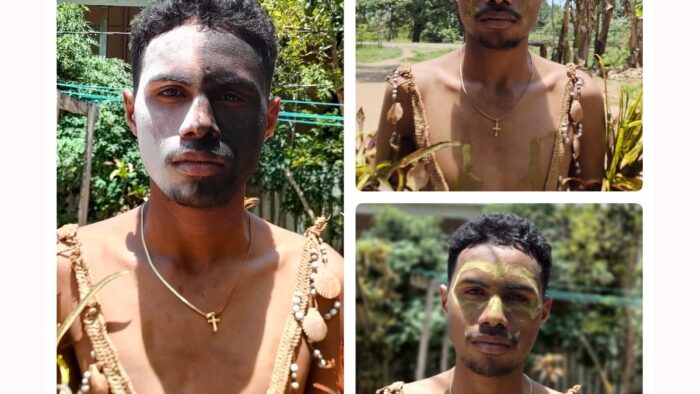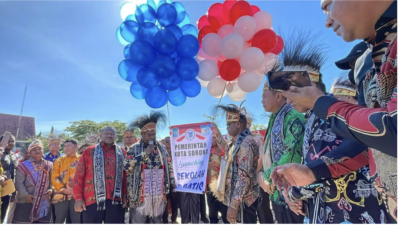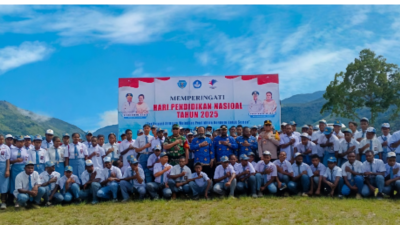Thelandofpapua.com – Indonesia’s cultural diversity is truly astounding, and nowhere is this more evident than in Papua. Home to numerous tribes, each with its unique traditions and customs, Papua is a cultural treasure trove. Among these tribes is the Malind tribe from South Papua, historically known as headhunters. While this might sound frightening, it’s important to understand the full story behind this fascinating culture.
The Malind Tribe: From Headhunters to Cultural Custodians
According to Van Baal, the Malind tribe, also known as Malind Anim, once engaged in headhunting for magical rituals. However, this practice was abandoned long ago as it became a legal offense, and the Malind people are now law-abiding citizens of Indonesia. Despite this, they hold onto their heritage as Anim Ha, or “True Humans,” maintaining a deep connection with nature. This connection is evident in their traditional ceremonies.
Traditional Ceremonies and Attire
The ceremonies of the Malind tribe are particularly captivating due to the distinctive attire worn during these events. During initiation ceremonies, Malind men don a loincloth made from dried sago leaves, anggin flower decorations on their arms, and a feather headdress called himbu. Malind women wear similar loincloths, anggin flower decorations, and headbands made from young coconut leaves. Essential ceremonial tools include the tifa, a percussion instrument, and bows and arrows.
The Significance of Himbu
The himbu headdress is iconic, resembling a crown made from cassowary feathers arranged upright with shell decorations. It is often seen in cultural showcases promoting Papuan heritage. However, the himbu is more than just an accessory; it is a symbol of cultural significance, traditionally passed down to men and worn only during initiation ceremonies by respected male members of the tribe, known as pakasanem or mitawal. The use of himbu is governed by strict spatial and temporal rules, underscoring its importance.
The Nggatsi Ceremony
During the Nggatsi ceremony, a grand event expressing gratitude to the Creator, Malind men wear a different headdress called ndiput or seseke. Made from cassowary feathers and rattan, this crown is designed to move gracefully as the wearer dances. Malind women, on the other hand, wear boka or wandar-wandar head decorations made from young coconut leaves during this ceremony. Their appearance is further enhanced with mayup makeup, signifying a woman’s readiness for marriage.
Totemic Symbols and Face Paintings
Face paintings, or huwe, are another fascinating aspect of Malind culture, reflecting totemic symbols of the major clans in South Papua. There are seven major clans, each with its totem:
- Mahuze: Dog totem
- Gebze: Coconut totem
- Basik-basik: Pig totem
- Ndiken: Bird totem (similar to a stork)
- Balagaize: Crocodile totem
- Kaize: Cassowary totem
- Samkakai: Wallaby totem
Each clan’s totem is represented in unique facial patterns during ceremonies. For instance, members of the Mahuze clan paint their faces to resemble a dog, with one side black and the other white. The Gebze clan uses yellow circular patterns around the eyes to symbolize the coconut. The Ndiken clan’s intricate design includes a yellow vertical line from the forehead to the nose and a horizontal line across the cheeks, with bird-like branches at the ends.
Cultural Colors and Their Meanings
The Malind tribe primarily uses three colors: black, white, and red. These colors, derived from natural materials, hold significant meanings:
- Black (Kunaihi): Wisdom
- White (Koihi): Neutrality
- Red (Dohi): Birth
Additionally, yellow symbolizes the greatness of God. These colors are not only integral to face paintings but also reflect the Malind people’s philosophical values.
Preserving Cultural Heritage
Understanding the attributes of the Malind people gives us a closer look at the Anim Ha culture, a precious cultural heritage from Papua. It is crucial to appreciate and preserve Indonesia’s cultural wealth, ensuring it remains an invaluable legacy for future generations.








